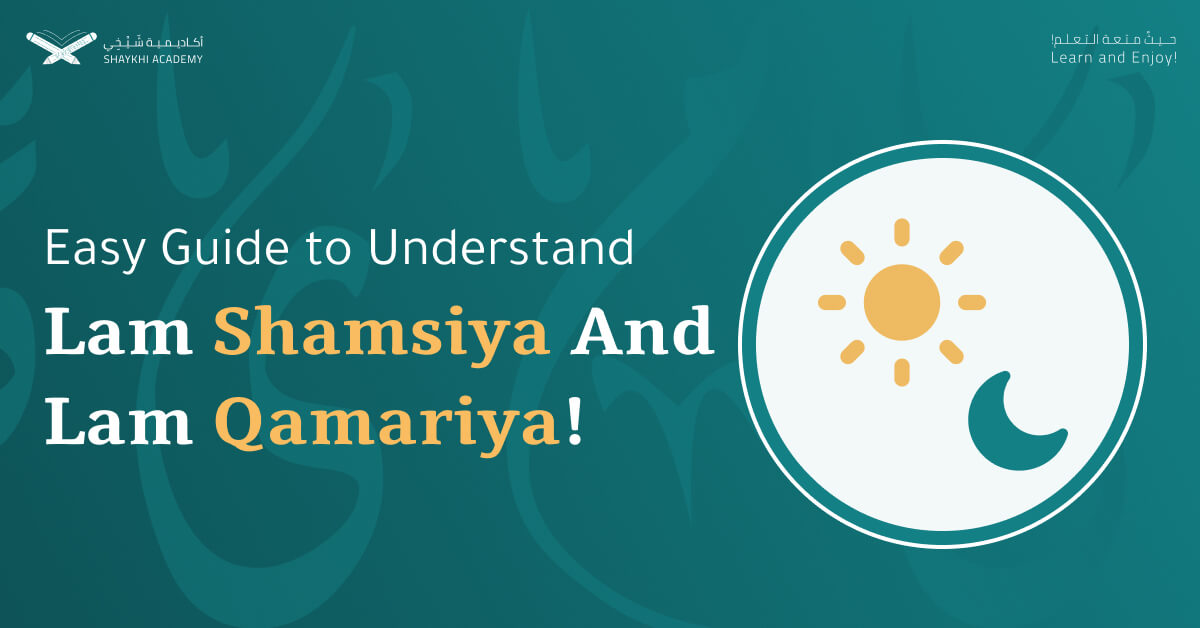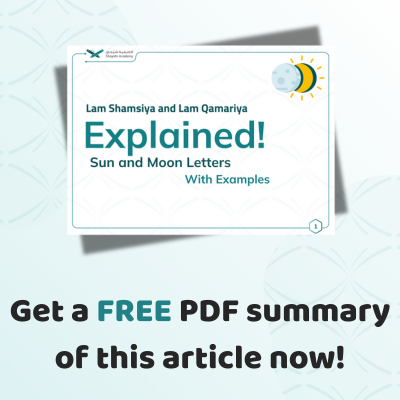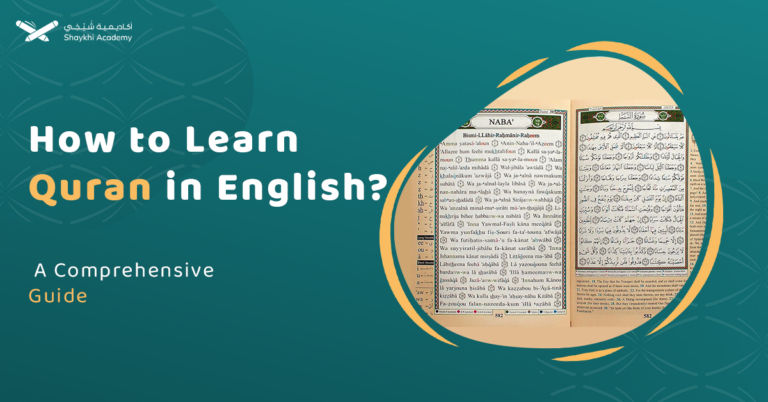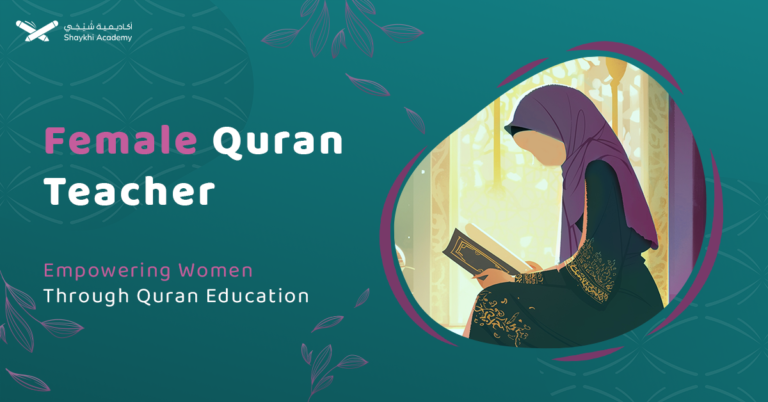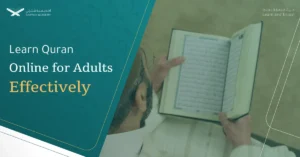The roles of Lam Shamsiya and Lam Qamariya in Arabic grammar extend beyond mere phonetic distinctions, playing a vital role in enhancing the beauty and precision of the language. The careful application of these rules contributes to the rhythmic cadence and musicality inherent in Arabic pronunciation.
Lam Shamsiya and Lam Qamariya:
In Arabic linguistics, the concept of Sun and Moon letters plays a significant role in understanding the assimilation of sounds within the language.
This linguistic phenomenon categorizes Arabic letters into two groups: Sun Letters and Moon Letters (Lam Shamsiya and Lam Qamariya). The distinction becomes particularly relevant when these letters are followed by the definite article “al” (ال).
An understanding of Lam Shamsiya and Lam Qamariya (اللام الشمسية واللام القمرية) is crucial for learners of Arabic, aiding them in mastering the intricacies of proper pronunciation and grammatical structure within the language.
What is Lam Shamsiya?
In Arabic grammar, Sun Letters (the letters of Lam Shamsiya) refer to certain letters that cause assimilation when followed by the definite article “al” (ال). The assimilation involves the “l” sound of “al” merging with the sound of the Sun Letter.
When one of these Sun Letters (اللام الشمسية) is followed by “al,” the “l” sound of “al” becomes part of the Sun Letter’s pronunciation, creating a smoother transition in spoken language. For example, the word “as-sayf” (السيف) becomes “as-sayfu” (السيفُ) when the Sun Letter “س” is followed by “al.”
What is Lam Qamariya?
In Arabic grammar, Moon Letters (Lam Qamariya) refer to certain letters that do not cause assimilation when followed by the definite article “al” (ال). The pronunciation of the “l” sound in “al” remains distinct from the initial sound of the Moon Letter. The Moon Letters in Arabic are:
When one of these Moon Letters (اللام القمرية) is followed by “al,” the “l” sound of “al” does not merge with the initial sound of the Moon Letter, and both sounds are pronounced separately. For example, the word “al-bayt” (البيت) remains “al-bayt” (البيت) when the Moon Letter “ب” is followed by “al.” Understanding Moon Letters is important for proper pronunciation and grammatical structure in Arabic.
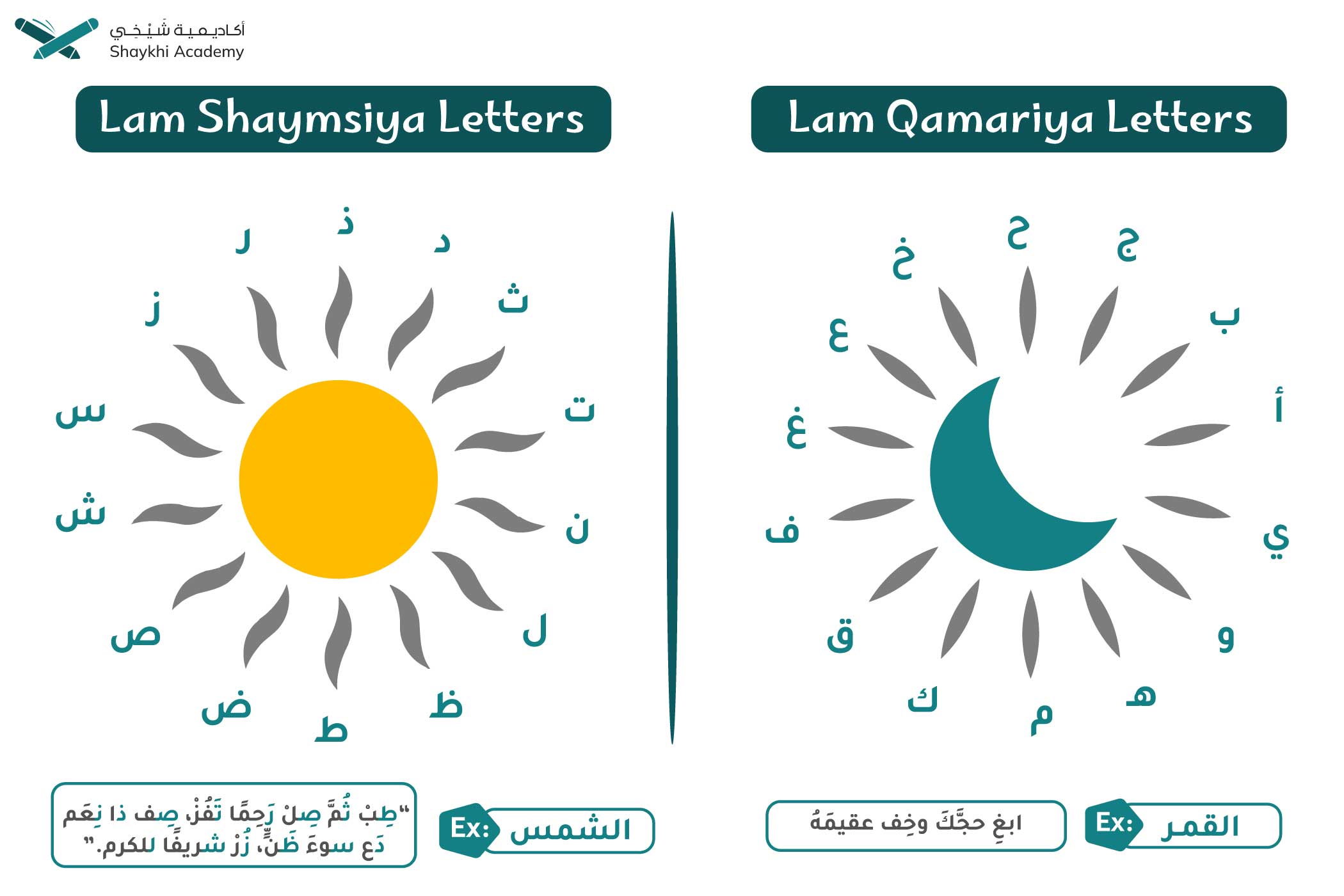
What’s The Difference between Lam Shamsiya And Lam Qamariya?
Lam Shamsiya: Is always written but never pronounced, And the Letters that come after it are either stressed or unstressed. Lam Qamariya: Is written, and pronounced. Moon letters are always Sukoon and the letters that come after are ALWAYS stressed.
The difference between Sun Letters and Moon Letters (حروف اللام الشمسية واللام القمرية) in Arabic grammar lies in their behavior when followed by the definite article “al” (ال).
1- The Sun Letters:
Sun Letters cause assimilation when followed by “al.” The “l” sound of “al” merges with the sound of the Sun Letter, creating a smoother transition in pronunciation.
The Sun Letters are always written but never pronounced, And the Letters that come after it are either stressed or unstressed.
For example: the original word: السيف (Al-Sayf) gets pronounced السيفُ (as-sayfu)
2- The Moon Letters:
Moon Letters do not cause assimilation when followed by “al.” The “l” sound in “al” remains distinct from the initial sound of the Moon Letter.
It is written, and pronounced. Moon letters are always Sukoon and the letters that come after are ALWAYS stressed.
For example: the original word: البيت (al-bayt) gets pronounced (al-bayt).
What Is the Importance of Learning Lam Shamsiya and Lam Qamariya?
Learning the Sun and Moon letters (Lam Shamsiya and Lam Qamariya) in Arabic is essential for several reasons, especially in the context of pronunciation, grammar, and Quranic recitation. Here’s a list of 10 reasons highlighting the importance of understanding the Sun and Moon letters:
1- Proper Pronunciation:
Knowledge of Sun and Moon letters (اللام الشمسية واللام القمرية) ensures accurate pronunciation, helping learners articulate words correctly, whether in everyday conversation or formal speech.
2- Clear Quranic Recitation:
For those reciting the Quran, understanding Sun and Moon letters is crucial for proper Tajweed, ensuring accurate and melodious recitation of the sacred text. Therefore, during Shaykhi Academy’s Quranic recitation courses, the tutors resort to explaining this grammatical rule to their students.
3- Grammar Accuracy:
Mastery of Sun and Moon letters (Lam Shamsiya and Lam Qamariya) contributes to grammatical accuracy in Arabic, particularly in the assimilation or non-assimilation of the definite article “al.”
4- Enhanced Communication:
Correct pronunciation improves communication skills, allowing learners to express themselves clearly and be better understood by native speakers.
5- Language Fluency:
Learning Lam Shamsiya and Lam Qamariya promotes fluency in spoken Arabic, enabling learners to engage in conversations more naturally and confidently.
6- Cultural Appreciation:
Understanding the linguistic nuances, including Sun and Moon letters, provides insights into the cultural richness of the Arabic language and its historical development.
7- Educational Foundations:
For students of Arabic language and literature, knowledge of Sun and Moon letters is fundamental to building a strong foundation in grammar and phonetics.
8- Religious Significance:
For those studying Islamic sciences, particularly Quranic studies, familiarity with Lam Shamsiya and Lam Qamariya is indispensable for an accurate understanding and recitation of the Quran.
9- Linguistic Precision:
Sun and Moon letters (اللام الشمسية واللام القمرية) contribute to the precision and eloquence of speech, enhancing the overall linguistic skills of Arabic learners. This is the reason why the rule of Lam Shamsiya and Lam Qamariya is a crucial part of Shaykhi Academy’ Arabic lessons; so that the learner can achieve verbal precision linguistically.
10- Respect for Tradition:
Studying Sun and Moon letters reflects a respect for linguistic traditions and adherence to the rules that have been passed down through generations, preserving the authenticity of the Arabic language.
11- Cultural Integration:
Knowledge of Sun and Moon letters facilitates cultural integration, allowing learners to engage more deeply with Arabic-speaking communities and understand linguistic nuances in various cultural contexts.
12- Teaching and Tutoring:
For educators teaching Arabic as a foreign language, a solid grasp of Lam Shamsiya and Lam Qamariya is essential to effectively convey these linguistic concepts to students, promoting successful language learning.
13- Poetic Expression:
Understanding Sun and Moon letters is advantageous for those interested in Arabic poetry. It aids in appreciating the rhythmic patterns and phonetic beauty found in classical and modern Arabic poetry.
14- Linguistic Analysis:
Linguists and language researchers benefit from studying Sun and Moon letters as part of their analysis of Arabic phonetics and morphology, contributing to a deeper understanding of Semitic languages.
15- Professional Development:
Proficiency in Lam Shamsiya and Lam Qamariya can be valuable for individuals working in fields such as translation, interpretation, or journalism, where accurate Arabic pronunciation is essential for conveying information effectively.
How Does Lam Shamsiya And Lam Qamariya Affect The Words?
The rules of Lam Shamsiya and Lam Qamariya refer to how the Sun and Moon letters affect the words; as the different conditions of Lam Shamsiya and Lam Qamariya effect pronunciation changes that occur when the Arabic definite article “al” (ال) is added to words that begin with the letters “Lam” (ل) and are followed by either a Sun Letter or a Moon Letter.
With Lam Shamsiya, when “Lam” (ل) is followed by a Sun Letter, it undergoes assimilation, meaning the “l” sound of “al” merges with the initial sound of the Sun Letter. An example of this is السيف (as-sayf) becomes السيفُ (as-sayfu) when the Sun Letter “س” is added.
With Lam Qamariya, when “Lam” (ل) is followed by a Moon Letter, there is no assimilation, and the “l” sound of “al” remains separate from the initial sound of the Moon Letter. An example of this is الباب (Al-bab) which remains Al-bab.
Letters of Lam Shamsiya And Lam Qamariya:
The Arabic word “Shams” becomes Al-Shams when the lam is added, and the word is pronounced “Ashmas”, meaning that the lam is silent, While the word “Qamar” becomes “Al-Qamar” and is also pronounced “Al Qamar” when the lam is added, meaning that the lam is pronounced and its on Sukoon.
The conditions of Lam Shamsiya and Lam Qamariya (اللام الشمسية واللام القمرية) change according to the letter that follows the ال.
The sun letters (Huruf Shamsiya) are represented in the first letter of every word in the poetry lines that follow, which were compiled by one of the poets.
“طِبْ ثُمَّ صِلْ رَحِمًا تَفُزْ صِفْ ذَا نِعَمْ دَعْ سُــــوءَ ظَــنٍّ زُرْ شَـرِيفًا للكَــرَمْ”
And they’re:
[ت / ث / د / ذ / ر / ز / س / ش / ص / ض / ط / ظ / ن / ل]
While moon letters (Hurof Qamariya) were combined together in the following sentence to make it easy to learn
“حجا غبي فك مخه وقع”
And the letters are:
[أ / ب / ج / ح / خ / ع / غ / ف / ق / ك / م / ه / و / ي ]
Laam Shamsiya and Qamariya in Tajweed:
In the context of Tajweed, the rules of Lam Shamsiya and Lam Qamariya are particularly important for proper Quranic recitation. Shaykhi Academy is aware of that, and integrates this rule among others in its Tajweed courses.
In Tajweed, the application of Lam Shamsiya and Lam Qamariya contributes to the beauty, precision, and authenticity of Quranic recitation. Here’s how Lam Shamsiya and Lam Qamariya apply in Tajweed:
1- Lam Shamsiya (the Sun letters):
When “Lam” (ل) is followed by a Sun letter, assimilation occurs, and the “l” sound of “al” merges with the initial sound of the Sun Letter.
This assimilation is crucial in maintaining the flow and smoothness of recitation.
2- Lam Qamariya (the Moon letters):
When “Lam” (ل) is followed by a Moon Letter, there is no assimilation, and the “l” sound of “al” remains separate from the initial sound of the Moon Letter. This separation ensures clarity in pronunciation.
Examples of Lam Shamsiya And Lam Qamariya from Quran
There are many examples of Lam Shamsiya and Lam Qamariya in the Quran. While learning the Quran, the learner finds themselves practicing the Sun and Moon letters intensely, which is one reason why Shaykhi Academy’s Quran Hifz classes are a rich source of knowledge and practice of this rule.
1- {وَالتِّينِ وَالزَّيْتُونِ}:
Here, Lam shamsiya was added to the word تين and turned it to التِّينِ, and it gets pronounced as at-Tin. And so is the word زيتون which became الزَّيْتُونِ, which gets pronounced Az-Zaitun.
2- {فَضَرَبْنَا عَلَىٰ آذَانِهِمْ فِي الْكَهْفِ سِنِينَ عَدَدً}:
Here, Lam Qamariya was added to the word كهف and, it turned into الكهف, to be pronounced as Al-Kahf, and not Ak-Kahf.
3- { فَسَبِّحْ بِحَمْدِ رَبِّكَ وَكُنْ مِنَ السَّاجِدِينَ ﴿98﴾ وَاعْبُدْ رَبَّكَ حتى يَأْتِيَكَ الْيَقِينُ }:
Here, Lam Shamsiya was added to the word ساجدين and turned it into الساجدين, which makes its pronunciation As-Sajedin. On the other hand, the word يقين turns to اليقين when the Lam Qamariya is added; so that, it is pronounced Al-Yaqeen.
How to Teach Kids Lam Shamsiya And Lam Qamariya?
Teaching Lam Shamsiya and Lam Qamariya to kids can be made engaging and effective through various methods. An important tip though is to get help from a professional tutor who is able to utilize all these methods accordingly to help the kid through an Arabic language course; such as Shaykhi Academy’s Arabic classes for kids.
1- Visual Aids:
Use colorful posters or flashcards featuring Sun and Moon Letters with corresponding examples. Create visual cues, such as a sun symbol for Shamsiya and a moon symbol for Qamariya.
2- Interactive Games:
Design games like bingo or matching games where kids associate Sun and Moon Letters with words. Utilize interactive online games or apps specifically designed for teaching Arabic phonetics.
3- Storytelling:
Integrate Sun and Moon Letters into simple stories or narratives that capture children’s imagination. Create characters representing Sun and Moon Letters to make the learning experience more memorable.
4- Hands-On Activities:
Engage kids in crafting activities where they create Sun and Moon Letters using playdough, clay, or other craft materials. Incorporate tactile experiences by having them trace over the letters using sand or textured surfaces.
5- Rhymes and Songs:
Develop catchy rhymes or songs that highlight the pronunciation patterns of Sun and Moon Letters. Encourage kids to sing along, making the learning process rhythmic and enjoyable.
6- Role-Playing:
Introduce role-playing scenarios where kids act out words containing Sun and Moon Letters. Use props or costumes to make the activity more interactive and fun.
7- Multisensory Learning:
Implement activities that stimulate different senses, such as touch, sight, and hearing, to reinforce letter recognition and pronunciation. Consider activities like tasting snacks that start with Sun or Moon Letters.
8- Word Building:
Provide building blocks or magnetic letters for kids to create words, emphasizing Sun and Moon Letters. Encourage them to construct short sentences incorporating these letters.
9- Educational Apps:
Leverage educational apps specifically designed for teaching Arabic phonetics, providing a technology-driven and interactive learning experience.
10- Outdoor Exploration:
Take learning outdoors by searching for objects or signs with Sun and Moon Letters in the environment. Create a scavenger hunt where kids find items related to these letters.
11- Puzzles and Worksheets:
Develop puzzles or worksheets that require kids to match Sun and Moon Letters with corresponding words. Include coloring activities that reinforce letter recognition.
12- Storybooks:
Use storybooks with vibrant illustrations that feature words with Sun and Moon Letters. Read aloud, emphasizing pronunciation and encouraging kids to repeat after you.
13- Group Activities:
Organize group activities where kids work together to identify Sun and Moon Letters in a collaborative setting. Foster a sense of teamwork through games or challenges.
14- Role Models:
Introduce role models or characters from popular children’s media who exemplify Sun and Moon Letters. Connect these characters to words and situations familiar to kids.
15- Celebratory Events:
Organize celebratory events or small parties where kids showcase what they’ve learned about Sun and Moon Letters. Use this as an opportunity for reinforcement and positive reinforcement.
Top Tips to Master Lam Shamsiya and Lam Qamariya
Mastering Lam Shamsiya and Lam Qamariya in Arabic involves understanding the pronunciation changes that occur when these letters are followed by certain types of letters. Here are some top tips:
1- Understand the Concept:
Before diving into specific letters, grasp the concept of assimilation (Shamsiya) and non-assimilation (Qamariya). Understand how the definite article “al” interacts with the letters “Lam” (ل) when followed by Sun Letters or Moon Letters.
2- Memorize Sun and Moon Letters:
Create a list of Sun Letters (Shamsiya) and Moon Letters (Qamariya). Memorize these lists to quickly identify which letters trigger assimilation and which do not.
3- Visual Aids and Mnemonics:
Use visual aids, charts, or mnemonics to remember Sun and Moon Letters. Associate Sun Letters with a sun symbol and Moon Letters with a moon symbol. Create mental images to make the distinction memorable.
4- Practice with Examples:
Work with examples of words that contain Sun and Moon Letters. Practice saying and writing these words to reinforce the correct pronunciation.
5- Listen to Native Speakers:
Exposure to native speakers is invaluable. Listen to Arabic speakers, especially those proficient in Tajweed, to grasp the natural pronunciation of words with Sun and Moon Letters.
6- Engage in Recitation:
If you are studying the Quran, engage in regular recitation. Apply the rules of Lam Shamsiya and Lam Qamariya during your recitation to reinforce the correct pronunciation.
7- Utilize Technology:
Leverage educational apps, online resources, or audio guides that focus on Sun and Moon Letters. Interactive tools can provide additional practice and reinforcement.
8- Create Flashcards:
Make flashcards with Sun and Moon Letters on one side and examples on the other. Use these flashcards for regular self-quizzing to reinforce memorization.
9- Practice in Sentences:
Move beyond individual words and practice Sun and Moon Letters in full sentences. This helps in applying the rules seamlessly in natural language contexts.
10- Peer Practice:
Practice with a language partner or a tutor. Exchange words and sentences, correcting each other’s pronunciation and reinforcing the rules together.
11- Record Yourself:
Use a recording device to record yourself pronouncing words with Sun and Moon Letters. Listen to the recordings to identify areas for improvement and track your progress.
12- Regular Review:
Periodically review the rules of Lam Shamsiya and Lam Qamariya to keep them fresh in your memory. Regular reinforcement is crucial for mastery.
13- Join Language Learning Communities:
Participate in online forums or language exchange groups. Engaging with other learners can provide additional insights, support, and opportunities for practice.
14- Celebrate Progress:
Acknowledge and celebrate your achievements. Recognize when you successfully apply the rules of Lam Shamsiya and Lam Qamariya, and use positive reinforcement to motivate continued learning.
15- Seek Professional Guidance:
If possible, seek guidance from a qualified Arabic teacher or a native speaker who can provide personalized feedback and correct your pronunciation. This direct interaction can be invaluable for improvement.
How to Teach Kids Lam Shamsiya And Lam Qamariya? (A Story)
This is the most well-known story used to teach children the difference between lam shamsiya and lam qamariya:-
The story is basically about a family known as the family of the definite article/Al Al-taaref (ال التعريف) who was blessed with identical twins. And because of their magical beauty, the parents named the first son Al-Shams and the other son Al-Qamar.
Al-Shams and Al-Qamar grew up and the father bought them games, which were the 28 letters of the Arabic alphabet. Suddenly, these games caused a fight between the two kids, and the father realized that he should divide those games between the kids.
He gave Al-shams 14 letters which are {ت، ث، د، ذ، ر، ز، س، ش، ص، ض، ط، ظ، ن، ل}. And gave Al-qamar the rest 14 letters {أ، ب، ج، ح، خ، ع، غ، ف، ق، ك، م، هـ، و، ي}. However, each brother imposed conditions on his letters; Al-qamar required that his letters produce the sound of the Lam, while Al-shams required that the sound of the Lam becomes silent with the letter that follows stressed. The two brothers’ debate was thus resolved, and they lived in peace, love, and happiness.
Learn Arabic with Native Arab Tutors at Shaykhi Academy Now!
Shaykhi Academy’s Fusha Arabic classes offer students a comprehensive and unique approach to mastering the Arabic language, providing a solid foundation in both classical and modern Arabic.
With a focus on teaching the intricacies of pronunciation, including the rules of Lam Shamsiya and Lam Qamariya, this Quran stands out for its commitment to linguistic precision.
Don’t waste any time, and start your journey today!
The rules of Lam Shamsiya and Lam Qamariya serve as an integral aspect of the linguistic tapestry that contributes to the enduring allure of the Arabic language, fostering an appreciation for its inherent beauty and depth.
